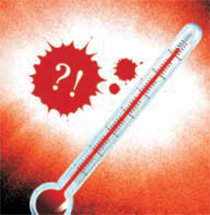Heat wave is a natural disaster
Heat wave is a natural disaster
Posted July. 23, 2018 07:32,
Updated July. 23, 2018 07:32

The heat that scorched west Europe in 2003 is considered as one of the worst natural disasters in history. With the daily average temperatures hovering around 40 Celsius degrees, a staggering 35,000 people were killed in the entire west European region. As many as 14,800 died from the extreme heat in France alone. Among them, roughly 10,000 were old men and women left alone in town, with the rest of population summering outside the city. Had it happened in South Korea, the entire nation would have been jolted. The event shed light on the dark side of France, an advanced welfare country.
South Korea has been stricken with many natural disasters, but it was the intense summer heat that took the most serious death toll of all. According to the National Institute of Meteorological Sciences, the massive heat wave in 1994 killed as many as 3,384 people in South Korea with the primary symptoms of dehydration and heatstroke. The second biggest culprit was Typhoon 3693 in 1936 (back then typhoons were numbered without being given a name), which took the lives of a whopping 1,104 in both Koreas before the liberation, and Typhoon Sarah is ranked in the third with a total death tool reaching 768 in 1959. These days, the temperatures in day hovers over 36 degrees Celsius in Seoul and 38 in Daegu. In the year of 2018 alone, some 801 patients have fallen with heat-related diseases nationwide, and eight have died.
Reportedly, the Ministry of the Interior and Safety will designate heat wave as a natural disaster along with cold snaps. Those two phenomena have been excluded the list of natural disasters as they occur over a duration of time, with room for maneuver. The impact of temperatures fluctuation has deepened, however, with the duration and the scope of damage has been expanded, allowing them the status of natural disaster. Pursuant to the local disaster safety law, natural disasters get a different level of attention in terms of budget and damage compensation.
Weather anomalies are no human error, but a failure to stop them is. Having been stricken with a massive heat wave or a canicule in 2003, the French government analyzed the cause of the disaster, the scope of responsibility, the result of treatment as well as a vast array of measures to improve the protection system of senior citizens over the course of a year following the event. When Chicago saw some 700 citizens die of excessive summer heat in 1995, the city government swiftly came up with prevention measures, and the number of victims dropped to 110 four years later when the largest city of the United States was hit by another bout of heat waves. Such cases draw a sharp with South Korea where it takes a full week to draw up response measures, and merely a year to fully delete the memory of historic natural disasters.
Kwang-Hyun Kim kkh@donga.com







